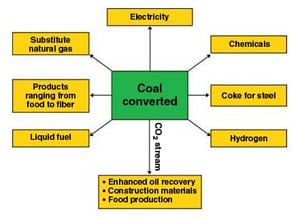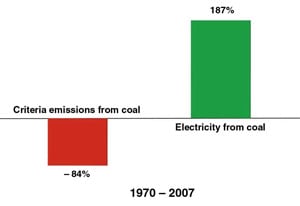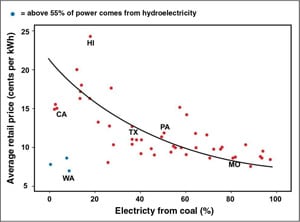"For decades, the coal industry has supported quality high-paying jobs for American workers, and coal has provided an important domestic source of reliable, affordable energy. . . . Charting a path toward clean coal is essential to achieving my Administration’s goals of providing clean energy, supporting American jobs, and reducing emissions of carbon pollution. Rapid commercial development and deployment of clean coal technologies, particularly carbon capture and storage (CCS), will help position the United States as a leader in the global clean energy race."
—U.S. President Barack Obama, February 3, 2010
President Obama has set three parallel goals for the United States: revitalizing the economy, improving energy security, and reducing greenhouse gas (GHG) emissions by 80% by 2050. All three of these policy goals will be pursued in the context of continuing population growth, as the number of Americans will grow from a current 310 million to almost 440 million by 2050. Clean coal technologies provide the opportunity for the U.S. to significantly advance toward resolving these issues by generating economic growth, enhancing energy security, and creating environmental solutions:
- Jobs. Replace 360 GW of traditional coal plants with highly efficient supercritical or ultrasupercritical plants with carbon capture and sequestration (CCS) by 2050. The National Research Council (NRC) found that this plan would provide the ability to generate up to 3,000 billion kWh of electricity. Such a construction program would dramatically stimulate the U.S. industrial sector, providing more than 28 million job-years spanning four decades.
- Energy security. Deploy a substantial number of coal-to-gas, coal-to-chemicals, and coal-to-liquids projects over the next 10 years, thereby reducing our reliance on increasingly scarce oil and volatile natural gas prices. Coal is easily the world’s most evenly distributed and abundant fossil fuel, and the U.S. has 29% of the global endowment, compared to 2% of the oil and 4% of the gas.
- Environment. Develop near-zero-emissions facilities that capture and store or use carbon dioxide; CO2 captured from coal conversion can be utilized in enhanced oil recovery (EOR) to produce at least 2 million barrels per day (b/d). Additional CO2 will be required for other value-added beneficial reuse opportunities, ranging from the production of cement to the production of iron oxide. Numerous studies have demonstrated that the U.S. has the geological capability to permanently store the remaining CO2.
For too long, too many have been focused on the wrong end game. The most immediate crisis the world confronts is not an environmental problem predicted by computer models but a real life human calamity fully within our power to solve.
We must put people first by striving for broad energy access for all. At the global level, the increased use of coal and clean coal technologies will expand electrification, the key to eliminating energy poverty. Coal is the dominant global baseload source of power. While the Copenhagen Accord stated that the eradication of poverty should be the top priority of developing nations, there is strong reason to argue that it did not go far enough. The elimination of abject poverty and energy deprivation is a global responsibility.
The world is confronted with a challenge of unprecedented scale: 2,600 million people live on less than $2 a day, 2,000 million have minimal access to electricity, and 1,400 million have no electricity at all. And another 2,000 million will require power as the world population continues to grow over the next two decades. This indicates that we are unacceptably on pace to have 5,000 million to 6,000 million people living without adequate access to electricity in just 20 years. Indeed, the major challenge of our time is not merely to reach 2050 with a decrease in GHG emissions but to also create reliable electricity access for the vast multitude of men, women, and children who toil grimly in the dark.
Access to electricity should be a human right. Every 10-fold increase in electricity is linked to a 10-year increase in life expectancy. The path to more people living longer and living better is clear:
- Eliminate energy poverty as a first-order priority.
- Create access to energy for everyone, everywhere by 2050.
- Advance all energy forms for long-term access, recognizing coal is the only fuel that can affordably meet the world’s rising energy demand at scale.
- Deploy advanced clean coal technologies to reach near-zero emissions from coal and natural gas power plants.
Coal is the only fuel with the abundance, technology, and versatility to meet the formidable challenges of the 21st century. Coal’s contribution to electricity generation is recognized as irreplaceable in the decades ahead. Thus, for years now, coal has been the world’s most rapidly growing energy source. Countries around the world are turning specifically to coal to meet their rising electricity needs. Globally, by 2035, the International Energy Agency (IEA, 2010) projects that coal generation will double to 16,455 billion kWh.
The U.S. has a unique opportunity to work within this global context and strive to deploy clean coal technologies to not only satisfy environmental goals but also to give billions a better life. Energy Secretary Steven Chu has confirmed that the emerging nations are now taking the lead.
India, for example, a nation with 400 million citizens living without electricity, is strongly pursuing advanced coal-based units under its Ultra Mega Power Projects to "provide power for all." Electrical Monitor (2010) reports that India has ordered 50 supercritical plants, 28 of which have been reserved by Chinese companies. And China’s 2007 "Large Substituting for Small" (LSS) program continues to reduce both consumption and emissions. Xiliang (2010) finds that the first year of LSS alone reduced China’s input requirement to generate a kWh from 357 grams of coal equivalent (gce) to 350 gce. A rapid supercritical buildout has subsequently reduced this amount to 339 gce. Looking forward, China’s ambitious ultrasupercritical plans include installing plants with efficiency levels of at least 46%, well above the global average of 28.4% for all coal plants.
Coal and Clean Coal Technologies Can Revitalize the U.S. Industrial Base
In a 2009 report, America’s Energy Future, the NRC designated coal-based generation with CCS as the primary source of electric capacity additions over the next several decades—providing the ability to generate up to 3,000 billion kWh of electricity. A construction program based on the NRC potential deployment pattern of 360 new GW of coal-based generation with CCS would reinvigorate America’s industrial core.
The loss of manufacturing jobs in the United States has been a focal point of concern for the Obama administration. The deleterious impacts on individuals, families, communities, and regions—as well as the U.S. as a whole—are readily apparent across the country. Rising energy prices since 2000 have played no small role in that process. For years, U.S. manufacturers benefited from affordable and reliable energy costs that allowed them to assume the center of the world’s economic stage. Over the past decade, however, higher and increasingly volatile prices have worked to erode that competitive advantage.
Coal’s unique low price stability advantage (coal-based electricity never exceeded $2.30 from 2005 to 2010) is the solution to this problem. The NRC (2009) has indicated that over the next several decades, coal-based generation with CCS can replace the existing coal fleet and provide up to 3,000 billion kWh of electricity per year at affordable rates.
The National Coal Council (NCC, 2009) found that the construction of about 360 GW of coal-based generation with CCS by 2050 will open up a new horizon for clean and sustainable energy at reasonable cost. Such a construction program would dramatically stimulate the U.S. industrial sector, providing over 28 million job-years spanning four decades. This investment in America’s future would have exceptional benefits, increasing the country’s gross domestic product (GDP) by more than $2.7 trillion. Research conducted for the AFL-CIO by BBC Research and Consulting (2009) indicates that the operation and maintenance of these facilities will provide more than 800,000 permanent jobs throughout the economy, thereby benefiting generations of Americans yet to come.
Clean Coal Will Enhance Energy Security
For the previous two generations, coal has provided roughly half of America’s electricity, and for the next generation, coal will continue to produce about 45%. Coal is embedded in the U.S. power delivery system: more than 35 states obtain at least 25% of their electricity from coal, and 25 of those receive at least 40%. In fact, U.S. coal produces over 2,000 billion kWh—about as much electricity as is used in France, Germany, Italy, Spain, and the United Kingdom combined. More than 215 million Americans (70% of the population) obtain at least 25% of their electricity from coal (Figure 1).

1. Coal is the cornerstone of America’s electricity system. Source: U.S. Energy Information Administration
Although the central role that coal has played in our socioeconomic progress is well documented, the coal story has really just begun. The U.S. is a growing country. We add three million people to the population each year, and projections indicate that by 2050 we will be approaching 450 million people. These increases in population and the reemergence of a healthy, prosperous economy will require ever-increasing amounts of energy and electricity; the U.S. will add about two Japans (over $9 trillion) to its GDP over the next 20 years.
Coal will continue to be the basis of affordable energy in the U.S. Coal’s greatest value, however, is its versatility; beyond electricity, coal can be converted into liquid fuels as well as substitute natural gas, chemicals, and a wide variety of other products (Figure 2). This unique attribute will be more vital as resources become more scarce and expensive in a world that will soon have eight billion people. Feedstock for chemicals will be in high demand around the globe. Power consumption will be driven by the rise of electro-technologies to meet the requirements of demographic and economic growth. Coal has the muscle required to meet these growing needs.

2. Coal’s versatility is its greatest value. Source: San Diego State University
Research by the NCC found that through established coal conversion processes the U.S. could utilize an additional 1,200 million tons of coal to produce 2.6 million b/d of oil, 4 trillion cubic feet (Tcf) of substitute natural gas, and fuel an additional 100 GW of new power plants. Furthermore, CO2 captured from coal conversion can be utilized in EOR to produce another 2 million b/d. The National Energy Technology Laboratory (NETL) found that EOR alone could create enough demand for CO2 to offset the emissions from 70 GW of coal-based generation for 30 years. NETL also reports that oil produced from EOR is 70% "carbon free."
Additional CO2 will be required for other value-added beneficial reuse opportunities, ranging from the production of cement to the production of iron oxide. A national EOR program would more than quadruple U.S. proven reserve totals and help compensate for longtime oil sources that are now fading, more expensive, or becoming more risky. The Natural Resources Defense Council touts CO2-EOR as a "win-win-win."
Clean Coal Is the Long-Term Environmental Solution
From the Intergovernmental Panel on Climate Change to the IEA to the European Union, there is widespread agreement that coal with CCS is the pathway to meeting climate change goals in the context of economic growth and stability. And the recent report of the Interagency Task Force for President Obama concluded that while "CCS can be applied to a variety of stationary sources of CO2, its application to coal-fired power plant emissions offers the greatest potential for GHG reductions. Coal has served as an important domestic source of reliable, affordable energy for decades and the coal industry has provided stable and quality high-paying jobs for American workers." Researchers at the Massachusetts Institute of Technology have identified CCS as "the critical enabling technology that would reduce CO2 emissions significantly while also allowing coal to meet the world’s pressing energy needs."
What’s more, the clean coal technologies implemented in the past several decades have been extraordinarily successful. Higher efficiency has greatly reduced emissions, and the coal plants being built in the U.S. today (such as Prairie State in Illinois) are among the cleanest in the world.
Indeed, clean coal technologies work. Since 1990, the U.S. electric power industry has invested almost $100 billion to control emissions with stunning success. Criteria emissions such as sulfur dioxide and nitrogen oxides have significantly declined since 1970, despite a dramatic increase in coal-based power generation (Figure 3). In recent years, the creative gaze of the scientific community has focused on CCS. Consequently, the technologies to begin deployment of coal-based power generation with CO2 capture at commercial scale are both available and affordable now: "technologies for carbon capture and sequestration from coal power plants are an essential tool to mitigate global climate change…current technology can do the job," states the Clean Air Task Force (2010). Secretary Chu’s 2009 commitment to bring up to 10 commercial demonstration projects online by 2016 is a crucial step in realizing the potential of coal-based power generation with CCS as identified in the NRC’s vision of America’s energy future.

3. Clean coal technologies work. Data are from 1970 to 2007. Source: U.S. Energy Information Administration
Concluding Comments
Coal is not a hypothesis. The infrastructure to produce, transport, and convert coal to electricity is already firmly in place. To supplant the electricity it derives from coal, the U.S. would need to build 250 new nuclear power plants (we now have 104) or produce an additional 15 Tcf of natural gas, which is twice the current production of Texas plus the Gulf of Mexico.
American coal generates 500 times the electricity of the Hoover Dam and produces half the electricity to run the Internet, computers, and electronic communication to control the immediate environment, to manufacture and transport our goods, to illuminate our streets and buildings, to heat and cool our food, and to store our medicines. The clean water, sanitation, and full range of pollution controls that we utilize every day are dependent on the reliable electricity that comes from coal. Coal is fundamental to steel production, a basic building block of the increasingly urbanized world; over 80% of our steel comes from coal. And, as seen in Figure 4, the more a state relies on coal-based power generation, the cheaper its electricity rates, which benefits both businesses and households.

4. More coal = lower-priced electricity. Source: U.S. Energy Information Administration
In addition, the construction of coal conversion facilities to supply liquid fuels, substitute natural gas, and chemicals will enhance our energy security in a world that will soon face, or perhaps has already passed, peak oil production.
In the U.S., building about 360 GW of coal-based generation with CCS by 2050 will open up a new horizon for clean and sustainable energy at reasonable cost. Such a construction program will revitalize the industrial sector of America. In short, the construction of these new coal-based facilities will widen the opportunities to utilize our most extensive energy resource in an affordable and clean manner, simultaneously meeting our economic, energy, and environmental goals.
At the global level, the increased use of coal and clean coal technologies will have parallel benefits but on an even larger scale. The world must extend electrification to give everyone, everywhere access to adequate, reliable, and affordable electric power. Simply put, we have no more important goal.
—Jude Clemente is an energy analyst and technical writer for the Homeland Security Department, San Diego State University.









